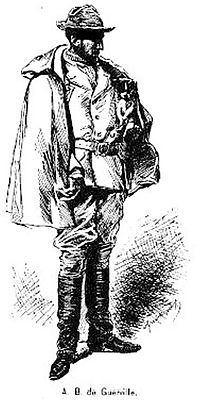- Amédée Baillot de Guerville
-
Amédée Baillot de Guerville, or A.B. de Guerville (May 3, 1869 - May 21, 1913), was a free-lance war correspondent, editor, and commercial agent, most frequently cited for his travel writing. He was best known in his day for his staunch defense of Japan in the aftermath of the alleged Port Arthur Massacre of November 1894.
Born to Paul-Louis-Amédée Baillot, clerk, commercial agent, and teacher of the French language, and his third wife, Antoinette Luce, Baillot followed what was apparently a family tradition of borrowing a portion of the Huet de Guerville family name, begun in England by his father in 1850 when he immigrated to the United States from his native France in 1887.
De Guerville began teaching French at Milwaukee Women's College in 1889. In 1890 he established the Le Courrier Francais newspaper for the Milwaukee and Chicago francophone community. Baillot began his career as commercial agent in 1891, with a stereopticon presentation of the 1889 Exposition Universelle de Paris (Paris World's Fair) to an audience in St. Paul, Minnesota. Around this time the American Tariff League accused de Guerville of having accepted money from French merchants and the Democratic Party to influence the Wisconsin elections of 1892. That same year de Guerville traveled to Japan, Korea, China, Ceylon, and Europe as a Special Commissioner for the World Columbian Exposition (the Chicago World's Fair) of 1893, where he promoted the event to kings, emperors, and heads of state.
In 1894 he returned to Asia, banking on contacts he made during the brief time he spent there in 1892 to secure an assignment as special correspondent covering the Sino-Japanese War, then known simply as the China-Japan War, for the New York Herald under the direction of James Gordon Bennett, Jr.. His primary competition was James Creelman, writing for The New York World. Creelman and Baillot came to journalistic blows regarding the massacre of Chinese civilians by Japanese troops at the Chinese city of Port Arthur on November 20–21, 1894. While Creelman, and other correspondents present, described a widescale and cold-blooded massacre, de Guerville alleged in the pages of the New York Herald that no such massacre had occurred.
Baillot married Laura Belle Spraker on December 23, 1896, in New York City. In 1900 Mrs. A.B. de Guerville filed for bankruptcy and divorce, but no divorce was ever granted. She died in 1940.
In 1898, a fire was reported at the offices of The Illustrated American, where de Guerville had taken over has part-owner and managing editor the previous year. Following the fire, but not necessarily as a result of it, de Guerville left the United States for good. In his version of events, the onset of a heretofore latent tuberculosis was the cause of his departure for his native France. By his own account, de Guerville experienced a near miraculous recovery from his tuberculosis while a patient at the pioneering Nordach Clinic for consumptives in Germany's Black Forest region.[1] Thereafter he continued to travel and write for a short while, producing his memoirs of his experiences in the Far East entitled Au Japon (1904), in which he admitted that the massacre had occurred while insisting it was Japanese coolies who had done the butchering.[2] He also wrote a well-received travelogue of British Egypt entitled New Egypt (1906). While in Egypt in 1906, A.B. de Guerville claimed to be the first man to race up the Nile in his motor-boat. In the last years of his life de Guerville was reported to have lived in Lausanne, Switzerland. During these latter years he also purchased land from in Valecluse in the south of France, where he is credited with developiing the land and expanding their golf course. He died in 1913, likely of the tuberculosis from which he claimed to have been cured. He is buried in the Alphonse Karr Cemetery in Saint-Raphaël, France.[3]
References
- ^ Amedee Baillot de Guerville, La lutte contre le tuberculose. Paris: Alphonse Lemerre, 1904.
- ^ Amedee Baillot de Guerville, Au Japon. Paris: Alphonse Lemerre, 1904, pp. 269-280.
- ^ Lindsay, Benoist. "We Are the Dead: The English Graves in the Alphonse Karr Cemetary of Saint-Raphael". web site of the Church of St. John the Evangelist in St. Raphaël, France. http://www.sjevar.com/history/WE%20ARE%20THE%20DEAD%20final,%20corrected%20version.pdf. Retrieved 2011-11-21.
Sources
- Guerville, A.B. de. The Crusade Against Phthisis." London: Hugh Rees, 1904.
- Guerville, A.B. de. Au Japon: The Memoirs of a Foreign Correspondent in Japan, Korea, and China, 1892-1894. Edited and with an Introduction by Daniel C. Kane. West Lafayette, IN: Parlor Press, 2009.
- Kane, Daniel C. "Each of Us in His Own Way: Factors Behind Conflicting Accounts of the Massacre at Port Arthur." Journalism History 31.1 (Spring 2005):23-33.
Categories:- 1868 births
- American journalists
- 1913 deaths
Wikimedia Foundation. 2010.

